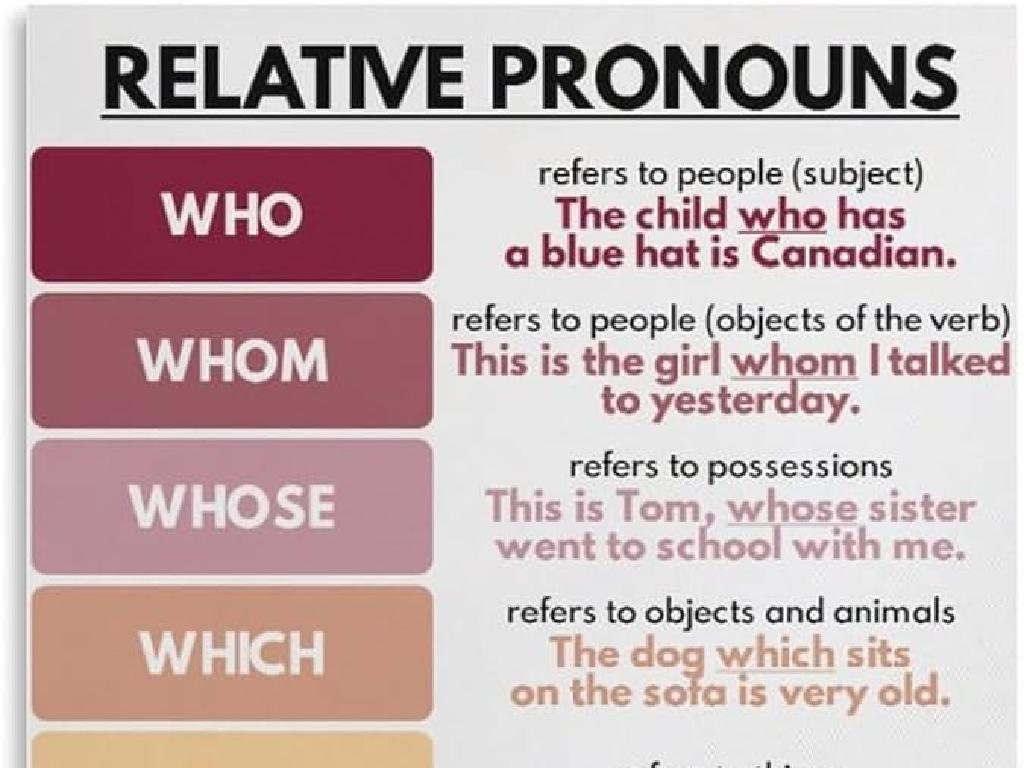Identify Active And Passive Voice
Subject: Language arts
Grade: Eighth grade
Topic: Active And Passive Voice
Please LOG IN to download the presentation. Access is available to registered users only.
View More Content
Active vs. Passive Voice
– Define active and passive voice
– Active voice: the subject performs the action. E.g., ‘The dog chased the ball.’
– Subject’s role in active voice
– Passive voice: the subject receives the action. E.g., ‘The ball was chased by the dog.’
– Subject’s role in passive voice
– Significance of voice in writing
– Understanding voice enhances clarity, engages readers, and can affect the tone of writing.
|
Begin the lesson by defining active and passive voice, emphasizing the role of the subject in each construction. Use clear examples to illustrate the difference, showing how the subject either performs or receives the action. Discuss why recognizing the difference is crucial: active voice generally makes sentences clearer and more direct, while passive voice can be useful for emphasizing the action itself or when the actor is unknown or irrelevant. Highlight how mastery of voice can improve students’ writing, making it more engaging and effective. Encourage students to identify examples of each voice in their reading and practice rewriting sentences in both voices to see the impact on clarity and tone.
Understanding Active Voice
– Define Active Voice
– The subject performs the action stated by the verb
– Examples of Active Voice
– ‘The cat chased the mouse.’ The cat (subject) performs the action.
– Identify subject and verb
– Subject is ‘doer’ of action, verb is the ‘action’ word
– Practice identifying Active Voice
|
This slide introduces the concept of Active Voice, which is a grammatical structure where the subject of the sentence performs the action expressed by the verb. Start by defining Active Voice and then provide clear examples that illustrate the subject actively doing the verb’s action. Emphasize the importance of identifying the subject and verb to determine if a sentence is in Active Voice. Encourage students to practice with sentences from their reading material or create their own examples. This will help them understand the structure and usage of Active Voice in writing and speech.
Understanding Passive Voice
– Define Passive Voice
– Passive Voice occurs when the subject receives the action.
– Examples of Passive Sentences
– ‘The ball was thrown by John’ shows the ball (subject) receiving the action.
– Focus shift in Passive Voice
– In Passive, the action is emphasized more than who is performing it.
– Recognizing Passive Construction
|
This slide aims to clarify the concept of Passive Voice for students. Begin with the definition, highlighting that in Passive Voice, the subject of the sentence is acted upon rather than doing the action. Provide clear examples to illustrate this point. Explain how the focus shifts from the subject to the action itself, which can be useful for emphasizing the action or when the actor is unknown or unimportant. Teach students to recognize the passive construction by looking for ‘to be’ verbs followed by past participles. Encourage them to convert passive sentences into active ones to see the difference in clarity and emphasis.
Comparing Active and Passive Voice
– Active vs. Passive Voice examples
– ‘The cat chased the mouse’ (active) vs. ‘The mouse was chased by the cat’ (passive)
– Guidelines for using Active Voice
– Use active voice for clarity and to show who is doing the action
– When to opt for Passive Voice
– Passive voice is useful when the action is more important than who is performing it
– Voice impact on sentence clarity
– Active voice generally makes sentences clearer and more direct; passive voice can add variety or focus on the action itself
|
This slide aims to help students distinguish between active and passive voice by providing clear examples. Emphasize that active voice is often preferred for its directness and clarity, making it easier for readers to understand who is performing the action in a sentence. However, passive voice has its place, especially in scientific writing or when the performer of the action is unknown or irrelevant. Discuss how the choice of voice can affect the meaning and clarity of a sentence. Encourage students to rewrite passive sentences in active voice and vice versa to see the difference in clarity and emphasis. This exercise will enhance their understanding of how sentence construction can change the focus of a statement.
Converting Between Voices
– Change Active to Passive Voice
– To convert, identify the object in the active sentence and make it the subject of the passive one.
– Practice conversion examples
– We’ll work together on sentences to apply the conversion rules.
– Tips for remembering processes
– Use the ‘by’ phrase to include the doer in passive sentences, and remember the verb ‘to be’.
– Class activity: Voice transformation
– Each student will convert sentences and explain their process.
|
This slide is focused on teaching students how to convert sentences from active to passive voice and vice versa. Start by explaining the structure of active and passive sentences. Emphasize the role of the object and subject in the conversion process. Provide clear examples and practice these as a class to reinforce learning. Share tips like looking for the ‘by’ phrase and using the correct form of the verb ‘to be’ to aid in conversion. For the class activity, have students work on transforming sentences from one voice to the other and explain their reasoning. This will help solidify their understanding and give them practical skills in identifying and using both voices effectively.
Activity Time: Identify the Voice
– Pair up with a classmate
– Receive a worksheet
– Worksheet contains various sentences
– Identify Active or Passive Voice
– Look for the subject performing the action (active) or receiving the action (passive)
– Discuss and mark answers
– Share thoughts with your partner and decide
|
This activity is designed to reinforce the students’ understanding of active and passive voice. By working in pairs, students can collaborate and discuss the differences between the two voices. The worksheet should contain a mix of sentences in both active and passive voice. Encourage students to look for the subject of each sentence and determine whether it’s performing or receiving the action. After identifying, they should mark their answers accordingly. As a teacher, walk around the classroom to assist pairs that might be struggling and to ensure that each pair is engaged in productive discussion. Possible variations of the activity could include having students create their own sentences in active and passive voice or having different worksheets with increasing levels of difficulty.
Review and Reflect: Active vs. Passive Voice
– Review class answers together
– Discuss Active vs. Passive preference
– Why is ‘The ball was thrown by John’ less engaging than ‘John threw the ball’?
– Reflect on voice in writing
– How does recognizing voice make your writing clearer?
– Enhance writing with voice understanding
|
This slide aims to consolidate the students’ understanding of active and passive voice through a class review. Engage the class in a discussion about the effectiveness of each voice in different contexts, emphasizing that active voice often makes sentences clearer and more direct, while passive voice can be useful when the doer of the action is unknown or unimportant. Encourage students to reflect on how this knowledge can be applied to their own writing to make it more powerful and reader-friendly. Provide examples and facilitate a conversation on how shifting the voice can change the impact of a sentence. This will help students to critically analyze and improve their writing style.
Homework: Active vs. Passive Voice
– Write 5 sentences in Active Voice
– Convert sentences to Passive Voice
– Explain your preferred version
– Do you like the directness of Active or the formality of Passive?
– Share your reasons in class
|
This homework assignment is designed to help students practice identifying and converting between active and passive voice. By writing sentences in the active voice and then converting them to passive, students will gain a better understanding of the structural differences between the two. Encouraging students to explain their preference will help them to think critically about the use of voice in different contexts. In the next class, students should be prepared to discuss their sentences and reasoning, fostering a collaborative learning environment where they can learn from each other’s insights.






